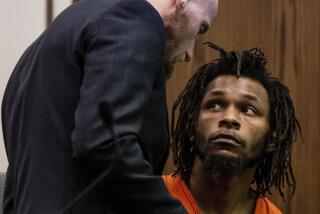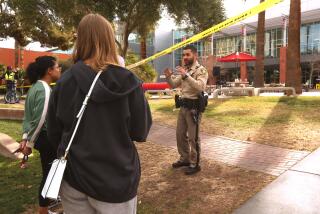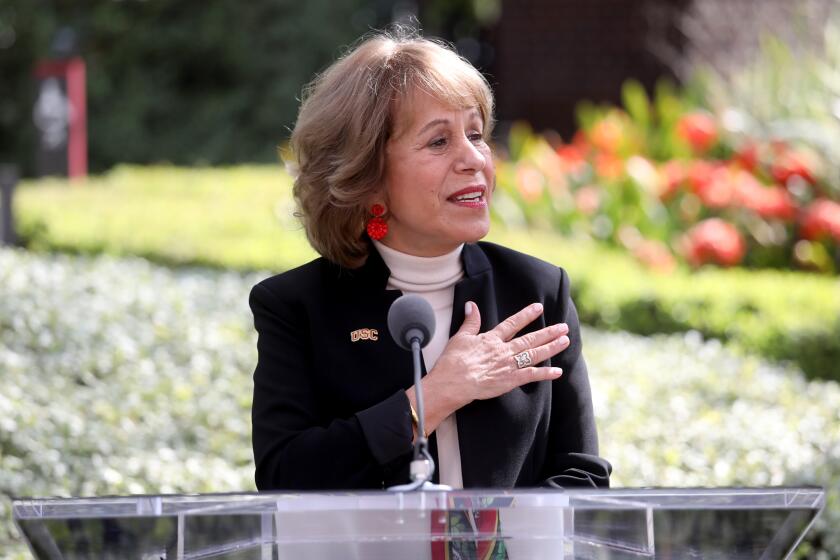Victim, Alleged Killer Shared Hopes, Passions
Like many a mentor and student, Chen Liang and Frederick Davidson shared a bond of common hopes and intellectual passions that seemed to transcend their differences in status, background and temperament.
The ebullient Chinese-born professor and the taciturn Army veteran graduate student worked closely on a project to develop a new metal alloy they believed could revolutionize the aerospace industry because of its ability to withstand heat.
For months they worked long into the night in a laboratory in the engineering building tucked away in a shady, isolated corner of the San Diego State University campus. Many of their colleagues felt that they were on the verge of a scientific breakthrough.
But on Thursday afternoon, in that same laboratory, Davidson allegedly pulled a gun he had hidden in a first-aid kit and methodically pumped 23 bullets into Liang and two other engineering professors, killing all three.
Davidson, officials said, acted in a fit of rage because he felt that the three were unfairly planning to reject his master’s degree thesis, ending his hopes of employment and respect and making his two years of hard work meaningless.
Davidson apparently had come to believe that Liang--his advisor, mentor and friend--was grabbing credit for his work and leading the drive to deny him his degree.
Liang, 32, was a sports and ballroom dancing enthusiast who had a brilliant academic and scientific future and lived in an upscale part of San Diego with his wife and two young children.
Davidson, 36, single and without a social life, lived minimally in a rented room near campus and had struggled for several years to finish his graduate work and cobble together a career in a declining industry.
“He was very much dependent on him,” Davidson’s landlord, a retired English professor, said of the tie between Davidson and Liang. “It seemed like he admired him very much, and at other times resented the way Liang was ‘exploiting’ him.”
Davidson and Liang coauthored papers for technical journals, enjoyed backyard barbecues at Liang’s home and dreamed of getting enough grant funding to complete their research.
On Thursday, Davidson had a 2 p.m. appointment with Liang and two other professors to attempt to answer their criticisms of Davidson’s master’s thesis. It was his final chance to earn his degree. The session had only begun when gunfire was heard.
Without saying a word, Davidson walked to a first-aid kit in the laboratory and took out a 9-millimeter semiautomatic gun he had stashed hours earlier, police said. Calmly, he walked toward Liang and allegedly shot him dead and kept firing.
The two other professors--D. Preston Lowrey III, 44, and Constantinos Lyrintzis, 36--fled in terror, but Davidson methodically followed them, firing, reloading and firing, 23 times in all, according to investigators. Lyrintzis was felled near the door of the laboratory, and Lowrey was shot to death while crouching in an adjoining computer room.
Sparing the lives of three fellow students who were in attendance at the master’s thesis “rebuttal” session, the stocky, balding, brooding Davidson paced the hallway outside the bloody laboratory, gun still in hand.
Campus police officers responded to frantic 911 calls about a gunman loose on campus and shooting professors. Confronted by three armed officers, Davidson begged for them to kill him and then meekly submitted to arrest, a suicide note tucked in his pocket.
“He was upset that his thesis had been turned down previously,” said San Diego Lt. Jim Collins, seeking to explain a crime that has shaken the tranquil campus that has not had a weapon-related crime since 1974. “He thought the professors were out to get him.”
Collins surmises that Davidson had planted the gun, which was registered in his name, in the first-aid kit hours before the 2 p.m. session. Dressed casually in a knit sports shirt and short khaki pants, he had arrived at the engineering department about 10 a.m.
Witnesses told police that Davidson, in the moments before the shooting, had appeared nervous, but nobody had been alarmed.
“He was sweating, but it was warm in the room, and there was no air-conditioning,” Collins said. “They all thought he was just a little tense about making his presentation on his defense.”
The session began with Liang making a few introductory comments. Davidson never replied, instead walking to the first-aid kit and beginning his brief but bloody rampage, Collins said.
It had been known that Davidson, who hoped to switch to mechanical engineering after failing to get a job in the dwindling aerospace industry, was angry at early criticisms of his work.
Davidson also resented his status as a temporary employee at the university, without benefits or job security, said Charles Brashear, who rented Davidson a room in his home near campus for two years.
In recent months his once-respectful relationship with Liang had soured.
“Sometimes he would say he felt so fortunate that he was Dr. Liang’s protege,” Brashear said. “Other times he would come in and say he thought Dr. Liang was exploiting him with long hours, little credit and short pay.”
In recent weeks, as the time for his thesis rebuttal drew near, Davidson become even more withdrawn. “He was moody these last couple of weeks. It’s not that we noticed it at the time, but he was unusually quiet,” Brashear said.
His obsession about the shaky job market for engineers grew. He once disgustedly pointed to a magazine article about a company that employs 68% of its workers on a temporary basis, Brashear said.
“He resented it,” Brashear said. “He was angry with the world, with the system, for creating so many temporary jobs and not giving people a fair shake.”
Brashear said he never knew Davidson owned a gun. Two years ago, however, Davidson went to the desert with a friend who had crafted a pistol from scratch. Later, Davidson showed Brashear a bullet-riddled Time magazine they had used as target practice.
Davidson will be arraigned Monday in San Diego County Superior Court on three counts of murder. He is being held without bail at the County Jail.
A native of Sacramento, Davidson served in the Army in the 1980s and then attended San Diego State from 1987 to 1991. He received a bachelor’s degree in aerospace engineering in 1991, just as the defense industry in Southern California was undergoing severe cutbacks.
While he was an undergraduate, Davidson worked at Composite Optics, an aerospace components firm in San Diego. David Chamberlin, the communications manager at the firm, knew Davidson as a manufacturing technician earning between $7 and $8 an hour from 1987 to 1991.
After getting his bachelor’s degree, Davidson continued to take classes at San Diego State. After failing to get an aerospace job, in 1994 he entered the master’s degree program in mechanical engineering.
Engineering is a rigorous discipline, and grades among engineering students are the lowest of any major on campus, said university spokesman Rick Moore.
“You present your work and questions are asked,” Moore said of a thesis defense session. “It’s more than a job interview and less than an interrogation.”
Liang, an assistant professor, had been on the faculty since 1994. Lyrintzis, a native of Greece, was an associate professor and a faculty member since 1987. Lowrey had been on the faculty since 1986 and was set to become the engineering department dean this fall.
Liang held bachelor’s and master’s degrees from Beijing Institute of Aeronautics and Astronautics and a doctorate from Virginia Polytechnic Institute and State University and worked as a research scientist at the Center of Intelligent Material Systems in Blacksburg, Va.
“He had all the makings of a superstar,” with more than 70 publications, said engineering dean Pieter Frick.
After moving to San Diego in 1994, Liang and his research chemist wife, Bai, bought a home in the Penasquitos neighborhood of San Diego. Their sons are ages 1 and 4.
Liang’s research was at the cutting edge of the “intelligent” materials and systems now used in airplanes and bridges, for example, to warn of metal fatigue and impending structural failure, said Craig A. Rogers, an engineering professor who was Liang’s doctoral advisor at Virginia. Rogers recently became dean of engineering at the University of South Carolina.
“He was incredibly productive and already had a wonderful reputation far beyond his years,” said Rogers.
Rogers said Liang was doing groundbreaking work on the subject of “muscle-like” smart materials called shape memory alloys and ceramics. He was working on things such as shoes with lights powered by running and curtains with stereo speakers built into the fabric.
Steven Weber, newly installed president of San Diego State, praised the professors as “three of our brightest and most promising teachers/scholars. . . . They were what we all strive to be, creators of the future.”
Also contributing to this story were Times staff writers Chris Kraul and Michael Granberry and correspondent Paul Levikow.
More to Read
Start your day right
Sign up for Essential California for news, features and recommendations from the L.A. Times and beyond in your inbox six days a week.
You may occasionally receive promotional content from the Los Angeles Times.






